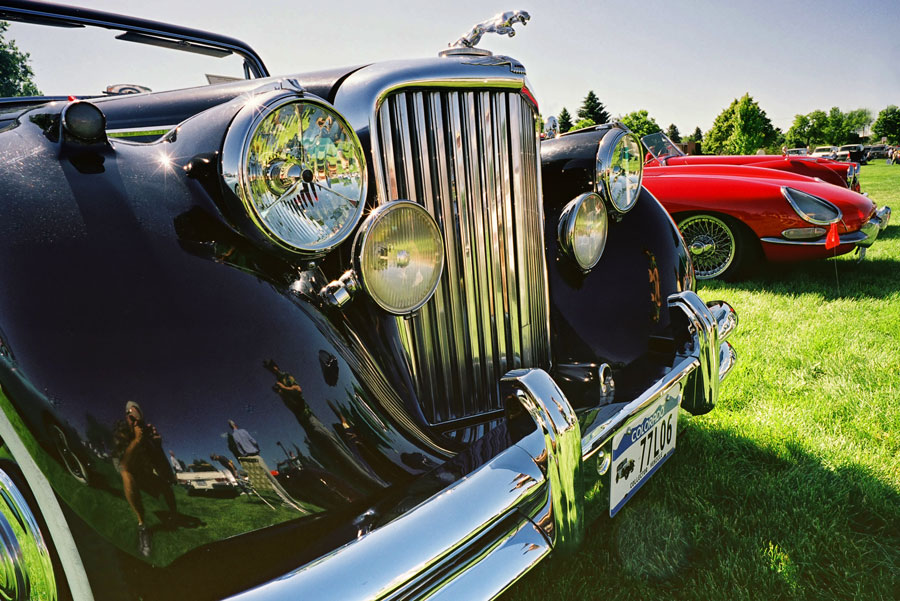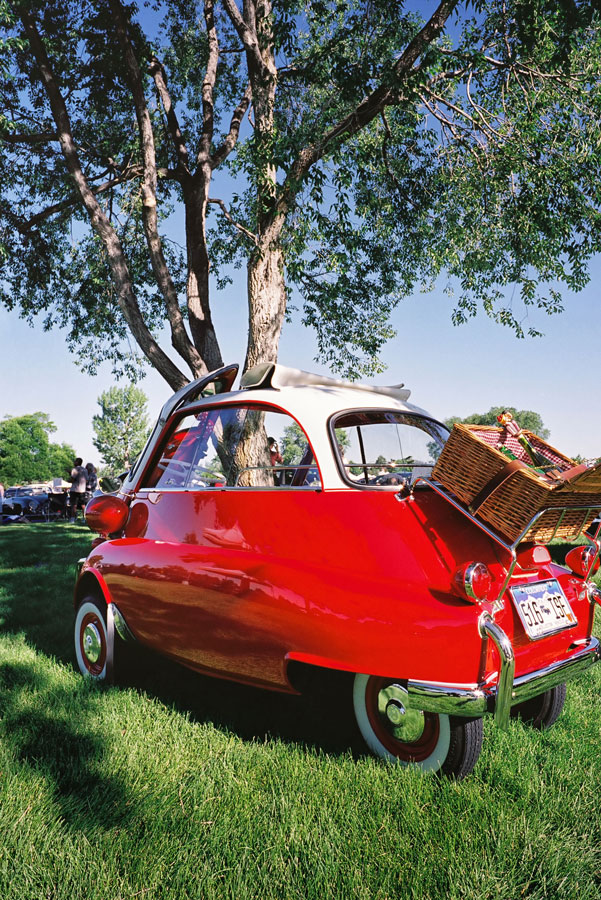Today’s Post by Joe Farace
On February 11, the sun was shining, snow clouds parted and temperatures were above 10 degrees F and the monthly Vehicle Vault Espresso & Exhaust was held. I dusted off my 40-year old Canon AE-1 and loaded it with Ilford HP5 Plus—in anticipation of writing a review about the film— and headed to the show. I shoot the entire roll and then drove to Mike’s Camera in Lone Tree to drop off the film for processing and scanning. The nice guy behind the counter told me the film would be ready to pick up on March 10th! And so dear friends it is my hope before that to shoot some of the color negative film from Lomography’s Analogue Quartet now in my possession and, with any luck at all, be able to post a review of Metropolis or LomoChrome Purple before March 10.
 The Classic Car Club of America defines “classic” as a fine or distinctive automobile, domestic or foreign, that was produced between 1925 and 1948. This definition isn’t universal and some people refer to cars like my 1953 Packard Clipper as a “classic.” The Antique Automobile Club of America considers vehicles 25 years old or more to be a Classic. And recognizing the increasing interest in cars of earlier eras, the Vintage Motor Car Club of America instituted the “Chrome Glidden Tour” for cars built in the 1920’s, 30’s, 40’s, and 50’s. So while the definition of classic might vary, I like to think that the “fine or distinctive” aspect of classic cars also extends to a camera that’s used to photograph the cars featured in today’s post.
The Classic Car Club of America defines “classic” as a fine or distinctive automobile, domestic or foreign, that was produced between 1925 and 1948. This definition isn’t universal and some people refer to cars like my 1953 Packard Clipper as a “classic.” The Antique Automobile Club of America considers vehicles 25 years old or more to be a Classic. And recognizing the increasing interest in cars of earlier eras, the Vintage Motor Car Club of America instituted the “Chrome Glidden Tour” for cars built in the 1920’s, 30’s, 40’s, and 50’s. So while the definition of classic might vary, I like to think that the “fine or distinctive” aspect of classic cars also extends to a camera that’s used to photograph the cars featured in today’s post.
How I made this photo: I consider the Zeiss Ikon SW 35mm camera to be a “classic. Its light weight and simplicity of design make it especially useful for the photographer who likes to use wide-angle image lenses that let you to get close to a car during crowded outdoor shows while letting you fill up the frame and eliminate background distractions.The 90 degree angle-of-view of the Zeiss 21mm Biogon f/2.8 ZM lens let me keep two classic Jaguars (above) in the same frame and in focus. The Mark V Convertible from the fifties in the foreground and an equally classic E-Type from the sixties in the background. The film was Kodak Ektar, exposure unrecorded,
 Exposure tips: When shooting slide film in the Zeiss Ikon SW 35mm set in Automatic mode, it’s a good idea to use the camera’s exposure compensation feature to slightly (one-third to two thirds stop) underexpose black cars or overexpose white cars. Otherwise the in-camera meter will try to make both kinds of cars a middle grey!
Exposure tips: When shooting slide film in the Zeiss Ikon SW 35mm set in Automatic mode, it’s a good idea to use the camera’s exposure compensation feature to slightly (one-third to two thirds stop) underexpose black cars or overexpose white cars. Otherwise the in-camera meter will try to make both kinds of cars a middle grey!
When shooting negative film, especially color negative film, I like to slightly (about one-third stop) overexpose negative film by rotating the A on the Zeiss Ikon’s shutter speed dial next to the desired adjustment that offers plus or minus two stops in one-third stop increments. In museums and collections that allow tripods, I’ll set the camera in manual mode and take an incident reading around the car using a hand-held meter to determine the exposure, whether it’s slide or negative film.
How I made this photo: During the 1950’s Isetta minicars were manufactured under license by BMW. This lovingly restored example is a classic in it’s own right. This photograph and all the others in this story, except as noted, are the full-frame 35mm film image. Using a optical finder that matches the 21mm lens is an important aid in composing your shots because these viewfinders show the area outside the image area allowing for more precise composition. The film was Kodak Ektar, exposure unrecorded,
Because of the increased interest in film photography, my log has had an increasing number of posts about film cameras, the film itself and the labs that process and most times scan your film. If this is of interest, check out the previous links as well as use that blog’s search box—that magnifying glass icon—to search for “film photography.”
If you enjoyed today’s post and would like to support this blog allowing me to increase coverage of film photography, you can make a monthly contribution via Patreon. Memberships start at just $1.25 a month, with additional levels of support at $2.50 and $5 that includes special benefits. If subscriptions are not for you, that same linked page allows you to make a one-time payment. If you would prefer to just send some good thoughts my way, that’s appreciated too.